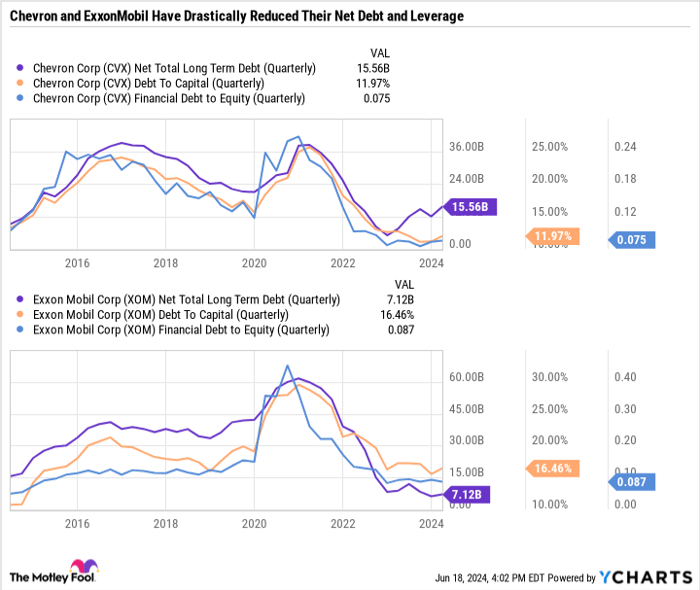Want $2,000 in Passive Income? Invest $15,000 in These 5 Dividend Stocks and Wait 4 Years
Generating passive income from quality dividend stocks doesn't look as appealing when the S&P 500 and Nasdaq Composite indexes are hitting new record highs. But the true value of dividend stocks isn't how they perform in the short term relative to the market, but how their consistency can help with financial planning and collecting passive income no matter what the market is doing.
United Parcel Service (NYSE: UPS), Chevron (NYSE: CVX), ExxonMobil (NYSE: XOM), Target (NYSE: TGT), and McDonald's (NYSE: MCD) are five dividend stocks that have sold off over the last three months. By investing $3,000 into each of these five stocks, you can expect to earn over $2,000 in cumulative dividend income over the next four years. Here's why all five beaten-down dividend stocks are worth buying now.

Image source: Getty Images.
This package delivery giant has a long way to go to restore investor confidence
UPS is getting dangerously close to reaching a four-year low. Operating margins have fallen off a cliff as UPS looks to cut costs and set realistic expectations for customer demand after badly overestimating a sustained surge in small package delivery volumes.
UPS has laid out a new plan to restore margins and return to growth by 2026. Healthcare is a key part of this push. But UPS said that it will rely on organic growth and acquisitions to drive the segment -- putting pressure on the company's ability to execute.
UPS is out of favor for good reasons, but it's important to remember it operates in a cyclical industry. With a yield of 4.8% and a price-to-earnings (P/E) ratio of 19.4 , UPS is giving investors a sizable incentive to buy and hold the stock while it turns things around.
Big oil, big capital return programs
It's been a good run for integrated oil majors like Chevron and ExxonMobil, which have seen their stock prices go from 15-year lows to all-time highs between 2020 and 2023. But both stocks have cooled off lately and are roughly flat over the last year despite a surge in the broader market.
Chevron and Exxon are returning a ton of cash to shareholders with buybacks and dividends. They have announced splashy mergers and acquisitions (M&A) in the pursuit of boosting cash flow to accelerate growth and their capital return programs.
Perhaps the biggest draw to both companies is their balance sheets. Leading up to the pandemic, Chevron was in a stronger financial position and had less leverage than Exxon. But Exxon has arguably benefited more from strong oil prices in recent years and has paid down a lot of debt. As a result, both companies are in excellent shape right now, sporting very low leverage.
CVX Net Total Long Term Debt (Quarterly) data by YCharts
Both companies have strategies to generate high free cash flow and cover the dividend even if oil and gas prices fall to $50 a barrel.
Chevron yields 4.3% -- besting ExxonMobil's 3.5%. However, ExxonMobil has a clearer corporate plan for the medium term. Instead of choosing between the two, it could be best to simply buy a 50/50 split of both stocks.
Target is slowly turning around
Earlier this month, Target raised its dividend for the 53rd consecutive year to a record high $4.48 per share -- representing a forward yield of 3.1%. That puts Target in an elite category of companies known as Dividend Kings -- which includes Procter & Gamble, Coca-Cola, and plenty of other stalwarts that have raised their payouts for at least 50 consecutive years.
If you browse the list of Dividend Kings, you'll find many consumer staples, utility, and legacy industrial companies. So it's particularly impressive that Target has been able to pay and raise its dividend for so long, given its discretionary product mix.
Target has rallied from its late October lows but is only up 6.5% in the last year compared to an over 30% gain for its peer Walmart. Target also sports a forward P/E ratio of 15.2 compared to Walmart's 27.8 and a higher yield than Walmart's 1.2%.
Target has already worked its inventory down and is boosting margins, but the recovery could accelerate if interest rates are cut and consumer spending improves. Either way, it's a good long-term holding thanks to the quality dividend, valuation, and Target's strong brand.
McDonald's is addressing the elephant in the room
Down over 15% year to date, McDonald's has been one of the worst-performing Dow Jones Industrial Average components so far this year. Similar to Target, McDonald's hit a wall with price increases and has faced some bad press in response to price comparisons between now and pre-pandemic.
To its credit, McDonald's has addressed these claims, saying many are exaggerated or flat-out false and that its price increases haven't outpaced the inflation rate. According to McDonald's, its input costs are up 40% over the last five years, so it has also raised prices by 40%.
McDonald's brand depends on value, convenience, and taste. But value is arguably the most important of them all. McDonald's is hyper-aware of the need to slow/stall price increases and create value options to reel customers back in. In the meantime, the stock has a 21.3 P/E ratio, a 2.7% dividend yield, and 47 consecutive years of dividend increases -- putting it just a few years away from becoming a Dividend King.
Ideal candidates for a passive income portfolio
UPS, Chevron, ExxonMobil, Target, and McDonald's may not be the flashiest companies. But they pay reliable dividends, which can come in clutch when equity prices are falling. This valuable feature is easily forgotten when the major indexes are soaring to new heights. However, long-term investors know that dividends are an excellent way to generate predictable and steady income, which can be reinvested or supplement income in retirement.
All five companies have strong yields and inexpensive valuations, making them ideal choices for investors looking for bargains without compromising on quality.
Should you invest $1,000 in United Parcel Service right now?
Before you buy stock in United Parcel Service, consider this:
The Motley Fool Stock Advisor analyst team just identified what they believe are the 10 best stocks for investors to buy now… and United Parcel Service wasn’t one of them. The 10 stocks that made the cut could produce monster returns in the coming years.
Consider when Nvidia made this list on April 15, 2005... if you invested $1,000 at the time of our recommendation, you’d have $775,568!*
Stock Advisor provides investors with an easy-to-follow blueprint for success, including guidance on building a portfolio, regular updates from analysts, and two new stock picks each month. The Stock Advisor service has more than quadrupled the return of S&P 500 since 2002*.
*Stock Advisor returns as of June 10, 2024
Daniel Foelber has no position in any of the stocks mentioned. The Motley Fool has positions in and recommends Chevron, Target, and Walmart. The Motley Fool recommends United Parcel Service. The Motley Fool has a disclosure policy.

